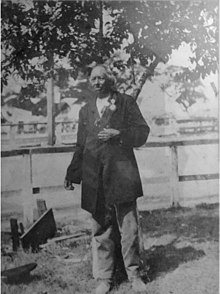Choctaw in the American Civil War
|
Interpreter/Private Jack Amos (Eahantatubbee) |
|
|---|---|

Jack Amos' Indian name was Eahantatubbee or "He Who Goes Out And Kills."
|
|
| Birth name | Unknown |
| Born | c. 1828 Lost Horse Creek found in near present-day Lauderdale County, Mississippi |
| Died | 1906 Newton County, Mississippi |
| Buried | Unknown |
| Allegiance |
|
| Service/branch |
|
| Years of service | 1861–1865 (CSA) |
| Rank | Private |
| Unit | 1st Choctaw Battalion and Spann's Independent Scouts |
Choctaw in the American Civil War participated in two major arenas- Trans-Mississippi and Western Theaters. The Trans-Mississippi had the Choctaw Nation. The Western Theater had the Mississippi Choctaw. The Choctaw Nation had removed west prior to the War. After thirty years of development, the nation had began to flourish in their new western environment. Their economic system was identical as the American South. The Choctaw Nation upper class was engaged in the cotton trade with networks reaching as far as New Orleans. However, the Mississippi Choctaw had a tougher existence. Thru treaty provisions, the Mississippi Choctaw elected to stay while the majority removed west. By the time of the Civil War, the Mississippi Choctaw were destitute and lived a sharecropper's existence. The most lucky of them had a patron who were sympathetic to their needs. Mississippi Choctaws were continually petitioning their grievances to U.S. authorities. Both the Choctaw Nation and the Mississippi Choctaw would ultimately side with the Confederacy.
Early 1861, the Confederacy appointed Albert Pike as an envoy to Indian Country. Pike successfully persuaded much of Indian country to side with the newly formed Confederate states. He conducted treaty terms and later commanded a combined force of Choctaw; Cherokee; Chickasaw; Creek; and Seminole troops. John W. Pierce and Samuel G. Spann organized the Mississippi Choctaw. They were both wealthly white planters and had experience with the Indians from Mississippi.
The Choctaw Nation had removed west of the Mississippi River after the signing of the Treaty of Dancing Rabbit in 1830. After three decades, the nation had become successful in establishing itself in its new country. Many tribal members had become successful cotton planters--owning many slaves. The most famous Choctaw planter was Robert M. Jones. He was part Choctaw and had become influential in politics. Jones eventually supported the Confederacy and became a non-voting member in the Confederacy's House of Representatives.
By 1860, the Choctaw Nation lived in a relatively calm and remote society. Many Indian citizen members had become successful farmers, planters, and business men. Angie Debo, author of the Rise and Fall of the Choctaw Republic, wrote: "Taken as a whole the generation from 1833 to 1861 presents a record of orderly development almost unprecedented in the history of any people."
Several reasons explain why the Indians sided with the Confederacy: (1) They believed the United States was on the verge of collapse, (2) They were neglected by the United States, (3) William H. Seward, the United States Secretary of State, advocated the seizing of Indian lands, (4) Their main agent was an advocate for the South, and (5) Their laws supported slavery.
...
Wikipedia
